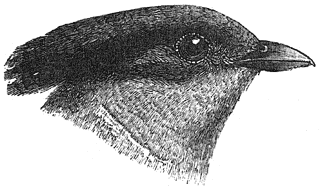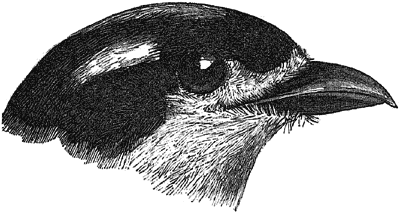Page 05 | prev page next page | ||
Genus SERILOPHUS, Swainson, 1837 Bill very much smaller than in Eurylaemus, sides of upper mandible straight, not overhanging. Tail much rounded. Secondaries and inner primaries truncated, and emarginate at the ends of the shafts. Rictal bristles present. Nostrils and tarsi as in Eurylaemus. Plumage soft, greyish or brownish above, ashy below; a white gorget in females only. Two species, ranging from the Himalayas to Tenasserim.
Primary quills, especially 3rd and 4th, sharply pointed, the worn inner web of the two feathers named having the edge concave near the tip. Coloration: Male. Forehead pale ashy, crown and nape pale greyish brown, back darker, passing into chestnut on the rump and upper tail-coverts; a broad black supercilium extending back to the nape; lores pale rufous with black hairs intermixed, ear coverts greyish rufescent; wings black, basal portion of outer webs of almost all quills greyish blue, a large white spot on the inner web of each, 3rd and 4th primaries with broad white tips, tertiaries and tips of inner webs of all quills except the first five pale chestnut, tips of the outer webs of the same feathers and of the fifth primary white; tail-feathers black, the outer 3 pairs with broad white tips; lower parts ashy grey, whitish on the throat and abdomen; lower wing-coverts and thighs black, edge of wing white. Female similar, but with a glistening silvery white gorget. Bill light blue, paler on the culmen; gape and base of both mandibles orange; mouth orange; eyelids greenish yellow; iris dark brown; legs greenish orange; claws light blue (Oates). Size: Length 7; tail 2.8; wing 3.4; tarsus 0.8; bill from gape 0.92. Distribution: Evergreen forests of Pegu hills, also Karennee and throughout Tenasserim. Not at present recorded outside British territory. | |||
|
Tips of outer primaries rounded. Coloration: Male. Head above, nape, and upper back dark ashy grey; a long black supercilium to the nape; back browner, passing into the ferruginous-red tertiaries, rump and upper tail coverts. Wings black, outer webs of almost all feathers dull blue near the base, corresponding to a white spot on the inner web; extreme tips of first 5 primaries white, of the remaining primaries chestnut, bordered inside with bluish grey; most of the wing-feathers except the first five with a small white spot on the outer web near the tip. Tail black, the three outer pairs of feathers with broad white tips. Lower parts ashy grey, under wing-coverts and thighs black; edge of wing whitish. Female with pure white tips to some of the neck-feathers, forming a narrow collar at each side but interrupted in the middle. Bill blue, paler towards the tip, a green spot, in the male only, in the middle of the lower mandible; iris greyish brown, naked skin round the eye dark yellow, narrow ring of the eyelid green; feet yellowish green, whitish-blue spots on the toes, nails whitish blue (Hattert); iris brown speckled with gold (Hume). Size: Length 7.25; tail 2.8; wing 3.3; tarsus 0.85; bill from gape 0.9. Distribution: Eastern Himalayas, below about 5000 feet, as far west as Nepal; Assam and the hills to the southward as far as Arrakan and Manipur.
Habits: Very similar to those of S. lunatus, but this bird is less tame. It feeds on insects, and Hume shot one in Manipur that had eaten
small land mollusca. The nest and eggs, which resemble those of the last species, have been described by Mr. Gammie in Sikkim, and by Mr. Baker in
Cachar, The eggs measure about 0.95 by 0.66. Genus PSARISOMUS, Swainson, 1837 Bill similar to that of Eurylaemus, but smaller, edge of upper mandible straight, not overhanging; no rictal bristles; loreal feathers directed forward. Tarsi indistinctly scutellated in front outside, the scutellation becoming obsolete inside. Tail greatly graduated, longer than the wing. General colour bright green. Sexes alike. A single species. Psarisomus dalhousiae, Long-tailed Broadbill
Fig. 6 - head of P. dalhousiae Coloration: Crown and nape with the sides of the head behind the eyes, black; a large blue-black patch on the crown; a narrow frontal line, an elongate spot behind the eyes, lores and chin bright yellow; passing into orange-yellow on the throat; this color is continued behind the black cap as a collar, the nuchal portion of which, sometimes difficult of detection in skins, is bright blue. Upper plumage from neck to tail coverts inclusive bright grass green; tertiaries and outer webs of secondaries the same; inner webs of wing feathers black; outer webs of primaries bright blue near the base, dark bluish green towards the tip, a large white spot on inner web of each primary near the base. Tail blue above, black below; lower plumage from breast bright bluish green. Female the same. In some skins the spot behind the eye is greenish yellow or white; the collar, too, has in many birds a satin-white hinder border. Bill green in general, but sometimes brownish yellow, gape and tip bluish or whitish; iris brown; orbits yellow or greenish; legs and feet dull light green; claws horny. Young birds have the whole head green or greenish. Size: Length 10.5 tail 5; wing 4.1; tarsus 1.1 bill from gape 1.3 Distribution: Throughout the Himalayas as far west as Dehradoon and Mussoorie, from a low level to about 6000 feet elevation; also Assam, Manipur, Cachar, and Burma generally, in hilly parts of the country, and through the Malay peninsula to Sumatra and Borneo.
Habits: This beautiful Broadbill is found usually solitary or in pairs, but sometimes in small flocks, and is restricted to thick forest. It
feeds entirely on insects, which it sometimes captures on the wing. The nests (fig.1) are like those of other Broadbills, large globular structures of
grass, roots, fibres, etc., with a lateral entrance, which is sometimes protected by an overhanging portico. This nest is suspended from a fine twig;
the egg-cavity is lined with green leaves; the eggs, 3 to 5 in number, are laid in April or May, and are of two types - the one pure white and glossy,
the other white or pinkish, blotched, chiefly about the large end, with red
and pale reddish purple, and almost without gloss. Average size 1.0 by 0.7. | |||
| prev page :: next page | |||
 birding.in
birding.in
| Birds | Bird Diagram | Ornithology | Indian Sites | Bird Watching | Migration | North India | Birds of India | Haryana |
All rights reserved. Copyright © 2005-2013 Birds and birding in India. Disclaimer
website: Free Java Guide & Tutorials

